Keystone XL

The Keystone Pipeline leaked about 5,000 barrels of oil in South Dakota on Thursday, according to TransCanada. The company said crews were able to shut down the pipeline early Thursday morning and began investigating the leak.

U.S. President Donald Trump will announce the approval of the Keystone XL oil pipeline at the White House on Friday, alongside the chief executive officer of builder TransCanada Corp, according to a senior administration official.
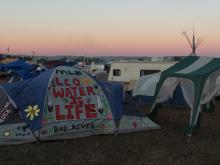
President Trump’s executive orders advancing the construction of pipelines are drawing condemnation from the Native American and religious groups that have opposed them.
The Standing Rock Sioux Tribe issued a statement on Facebook saying the president’s order Jan. 24 regarding the Dakota Access pipeline, to extend from the oil fields of North Dakota to Illinois, violated both U.S. law and tribal treaties.
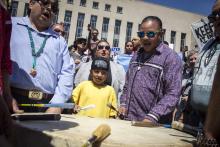
Unlike the Keystone pipeline protests, which garnered headlines around the world, the Standing Rock protests have largely gone ignored – silenced, in McKibben’s words, as a result of “the endless history of unfairness” experienced by Native Americans.

After seven long years of review, the White House plans to reject the request from a Canadian company to build the Keystone XL pipeline, according to The New York Times.
Envrionmental groups across the United States, including 350.org, have begun celebrating the news as a victory for climate activists. Sojourners has long spoke out against the construction of the Keystone pipeline and celebrates this news a win for all those advocating for the protection of creation.



In November, when the Senate just barely failed to pass a bill approving TransCanada’s controversial Keystone XL tar sands pipeline, Sen. Mitch McConnell (R-Ky.) interrupted the debate that followed it to tell everyone that we hadn’t seen the last of Keystone XL. He vowed that a new bill authorizing the pipeline would be the first thing on President Obama’s desk in the next session of Congress.
Sen. McConnell is making good on that promise – with another upcoming vote, he says he has the 60 votes he’ll need to pass the pipeline, which the GOP has branded as a “jobs creation” bill with dubious claims about job numbers.
But White House Press Secretary Josh Earnest announced today that “If this bill passes this Congress the president, wouldn't sign it.” This promise of a veto may have less to do with the environmental implications of the pipeline, the violation of a treaty with American Indians, or the years of steady protest from vocal opponents, and more to do with giving the State Department time to finish their review process. Regardless, it’s another stalled start for the would-be Keystone XL pipeline.
The White House needs to hear from Christians who oppose the Keystone XL pipeline. Click here to send a tweet to President Obama!
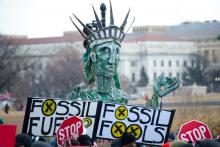
Last night, the Senate voted on the Keystone XL pipeline — and with only 59 votes, the bill failed. (In the current political climate, it takes 60 votes to make a bill filibuster-proof so that it actually passes.)
Right after the announcement, things got loud on the Senate floor. Someone from the gallery broke out into song. Although the C-SPAN cameras didn’t show them, someone was singing loudly in the Dakota/Lakota language from the gallery up above. That someone was Greg Grey Cloud, a member of the Dakota/Lakota Nation from the Rosebud Sioux reservation.
See, in some ways, the Keystone pipeline is a symbol. If President Obama lets the pipeline pass, it shows us that he isn’t actually the president who cares the most about climate change — even if he makes major agreements on climate change pollution with China or releases the Clean Power Plan for the EPA. If he lets the Keystone XL tar sands pipe be built, he’ll be undoing so much good work, cancelling it out with a fuel even dirtier than oil.
WONDERFULLY, WE FIND ourselves very much alive in “a large and beautiful house,” as Cicero called it in his day. We know it was built not only for “the sake of mice and weasels,” or “immortal gods,” but for the entire array of life on Earth.
As we behold the remarkably habitable abode we call Earth, we are left to wonder: What is this grand house in which we live, move, and have our being? What makes it such a habitable abode?
The answer is written elegantly before our eyes in creation itself. And when we join this with reading God’s word, we find the foundation of the answer: “The [geophysical] earth (ge) is the Lord’s and its fullness, the [biosphere] (oikoumene) and everything that lives in it,” as it says in the Septuagint translation of Psalm 24:1.
We discover as grateful dwellers in this most habitable abode that we also are its housekeepers. If we mess it up, it will teach us something about proper housekeeping. And from scripture we learn that we are its Earth-keepers, commissioned, as the Anglican Communion puts it, “to strive to safeguard the integrity of creation and sustain and renew the life of the earth.”
In the beautiful architecture of Earth, we find the foundations of life in the geophysical earth as well as keystone species in its biosphere. In the architecture of our houses and churches, we find structures of our own crafting, such as foundations, cornerstones, columns, arches, domes, and keystones.
Significantly, one of these architectural features appears in the name “Keystone XL,” the proposed tar sands oil pipeline. Architecturally, a keystone locks together two legs of an arch. If completed, Keystone XL would do much the same.
On the surface, what happened on Saturday at the nation’s capital was not extraordinary — just another rally for another cause to call the president to add another item to his to-do list. It may have been noteworthy to watch thousands of people from across the country march for climate action and then hold hands in a circle, or to see farmers and tribal leaders lead the crowd on horses, or to hear singer-songwriter Neil Young speak. Still, to a spectator, the Reject & Protect march could have been dismissed as another gathering for hippies and treehuggers or another picture for Instagram.
To overlook the significance of the march, however, would do injustice not only to the events of last week but also to the history surrounding them.
On Tuesday, April 22 (Earth Day), 24 farmers, ranchers, and leaders of indigenous communities rode to Washington, D.C. on horseback to launch the Reject & Protect campaign: a call to President Obama to reject the construction of the Keystone Pipeline (KXL) in order to protect the lands, waters, and communities located along the proposed pipeline.
The arrival of the Cowboy Indian Alliance inaugurated a week of ceremonies, film screenings, meetings, and other events promoting the anti-pipeline movement and climate action.

Editor's Note: Today’s #EarthWeek action: Join us for a prayer conference call at 2:30 pm Eastern Time as we hear from the evangelicals standing against the Keystone XL pipeline, and pray a blessing over them and their work. Click here to RSVP.
Maybe I’m a near-sighted, Bible-thumping holy roller, but I can’t see angel wings flapping on oil executives. No doubt some are community pillars. They’re Little League umpires, tithers, and PTA volunteers. They’ve got lovely houses and manicured lawns.
But they’re also flawed like the rest of us, and their professional bias screens out the obvious: The proposed Keystone XL Oil Pipeline would do little good and could wreak enormous harm. I’m compelled to halt my timid thy-will-be-done prayers and join a band of evangelicals boldly pleading for the permit’s denial. We’ve even launched a Facebook page, called “Pray No KXL.”
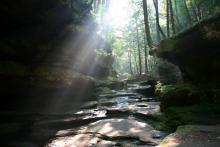
There’s an old hymn that many Christians have sung for nearly a century. “How Great Thou Art” celebrates the glory of God while considering, “all the works thy hands have made.” It reminds me of the psalm that reads, “The heavens are telling the glory of God; and the firmament proclaims his handiwork. Day to day pours forth speech, and night to night declares knowledge.”
Creation, therefore, is a witness to the wonder and awe of God. Although humanity has been given the honor of bearing God’s image, the earth shows God’s creativity and ingenuity. Over the years I’ve heard so many stories of people finding faith in God, not because of brilliant arguments, but because they are in awe of the complexity and glory of the created world.
But creation is not just a unique witness to God’s glory — it is, as the apostle Paul wrote, “groaning” waiting also for its redemption. This past Easter Sunday, Christians all over the world sang joyful songs of resurrection and renewal. Many of these songs proclaim freedom for all of creation — not just for humanity. One church I know of even sang “Joy to the World,” in celebration that the power of Christ’s resurrection extends “far as the curse is found.”
It’s hard to face, but humanity — image bearers of God — is largely responsible for destroying much of this great witness to God’s glory.
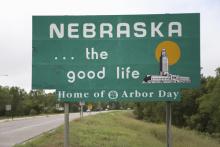
Deuteronomy 8 says “the Lord your God is bringing you into a good land, a land of flowing streams, with springs and underground waters ... a land where ... you shall bless the Lord your God for the good land he has given you.
When you arrive in Nebraska, signs on the interstate will welcome you to “The Good Life.” The folks who came up with our unofficial state motto may or may not have had the passage from Deuteronomy in mind, but to witness Nebraskans’ love for their land is to understand that it is a quietly sacred connection.
That connection found its voice in Nebraska citizens’ four-year battle to stop the TransCanada pipeline. In face of the threat of oil spills polluting the underground Ogallala Aquifer, of construction spoiling the fragile Sandhills region, and of a foreign corporation using bully tactics to seize landowners’ property, a remarkably diverse coalition of farmers, ranchers, environmentalists, Republicans, Democrats, Independents, grandmothers, students, and citizens took hold to protect Nebraska land.
Don’t let the media tell you that nothing is going to happen in Washington this year. Sure, Congress may be gridlocked on major legislation as we approach midterm elections, but key decisions are set to be made that will define President Barack Obama’s legacy on climate change. In the coming months, the Environmental Protection Agency is finalizing carbon pollution standards for both new and existing power plants, and the Obama administration will make a final decision on the Keystone XL pipeline.
Because the impacts of climate change, such as drought, more severe weather, flooding, and crop devastation, are more harmful to the world’s poor, these decisions will affect the lives of vulnerable people everywhere. As a Christian, I cannot sit idly by while God’s children are suffering from the devastating effects of irresponsible environmental degradation. I am joining with other people of faith in articulating the moral urgency of caring for God’s creation.
The U.S. needs to quit its crude oil habit. TransCanada needs to see the individuals whose health is directly threatened by Keystone XL. The president and legislators alike need to act for the welfare of not only this generation but for the generations to come, if we indeed want to see the flourishing of future generations. We need to admit to our addiction to oil and identify its harmful ecological impact for what it is.
As a person of faith, I want to see our landscapes, waters and skies restored to wholeness. I am compelled by the love I’ve received from God and God’s people to work alongside others for the common good of all. Having experienced the crisp June evenings of Minnesota as well as the asthma-inducing smog of Hong Kong, I know both the beauty of fresh air and green spaces and the dullness of pollution and gray skies. The chances of enjoying the former are quickly dwindling at our current rate of oil consumption, but we still have time to prevent further environmental degradation, if not for future generations then at least for those of us who still look forward to the rest of their lives, no matter our age.
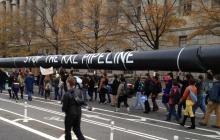
Friday at 3 p.m. ET, the State Department released their long-awaited final Supplemental Environmental Impact Statement of the Keystone XL pipeline extension, a proposed project from TransCanada to build a new pipeline for transporting tar sands crude oil from Canada to a refinery in Texas where it will likely be exported internationally.
Environmentalists and concerned citizens on the pipeline’s pathway have been waiting for the State Department to address previously ignored issues like the pipeline’s impact on climate pollution. President Obama said in a climate-focused speech last year that he would only approve Keystone XL if it did not pose a significant risk of climate pollution, so although State Department looked at other environmental risks as well (such as the 1,692 pipeline spills or incidents that occurred from 2002 to 2012 in the United States). This review concludes that the number of U.S. jobs to be created – once estimated in the tens of thousands – will actually be 50 operations jobs, with only 35 permanent. The rest (the touted 42,000 number) are all temporary construction jobs.
OFFICER MARIO normally worked for Homeland Security. On this Friday night he’d been seconded to the Washington, D.C. Metro police, who had their hands full. Not only did they have the usual “drunk and disorderlies,” but now 54 people who looked like card-carrying members of the AARP were filling up their holding cells. Officer Mario, of retirement age himself, was feeling fortunate. He’d been assigned to the women’s side.
“Ladies, ladies, ladies!” Mario said, sauntering in with a mischievous smile. “This must be my lucky night.”
The evening before, we’d all been at St. Stephen and the Incarnation Episcopal Church running role plays on how to “flash mob” the corporate headquarters of Environmental Resources Management (ERM), the firm hired by the U.S. State Department to provide an environmental impact statement on the Keystone XL pipeline. To the disbelief and concern of climate scientists, ERM claimed that TransCanada’s Keystone pipeline would not significantly contribute to climate change. ERM was suspected of “misleading disclosures” regarding conflict of interest and material gain from the pipeline’s completion.
Our white-haired mob of mostly grandparents converged on ERM headquarters at noon to shine a light on such shady dealings. While six silver foxes blocked the elevators by chaining their arms together inside a PVC pipe, I watched two D.C. police lift Steve, age 70, and toss him into the crowd behind me. I knew this nonviolent civil disobedience wasn’t going as planned.
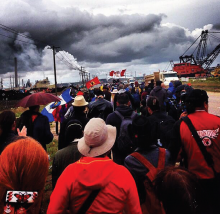
Environmental activist Bill McKibben took part in the July 5-6 Healing Walk, a spiritual gathering in northern Alberta, Canada, focused on the destruction—to the immediate environment and to the climate itself— caused by tar sands oil extraction and the Keystone XL pipeline across the U.S.
TO WALK, SLOWLY, across the tar sands complex of Alberta is to see our real-life equivalent of The Lord of the Rings’ Mordor. It really is as bad as everyone says. On this one eight-mile loop, we saw vast stretches of muskeg turned into dry, sandy desert; we saw dry-sandy desert that had been further converted into inky tailings lakes; and we were never out of earshot of the cannon that fire all day and all night to keep ducks from landing in the toxic waters. This goes on forever. The most comprehensive way to see it is from the air, I guess, but the best way to feel it is on foot.
Especially if you’re walking with the people who know this land best—have known it for thousands of years. Each year since 2010, local First Nations groups have organized a Healing Walk through the tar sands, and this year’s fourth iteration was by far the largest. Hundreds of people from around the continent camped for several days in a stretch of nearby boreal forest, held workshops and ceremonies, and then emerged for the hike through the industrial barrens.